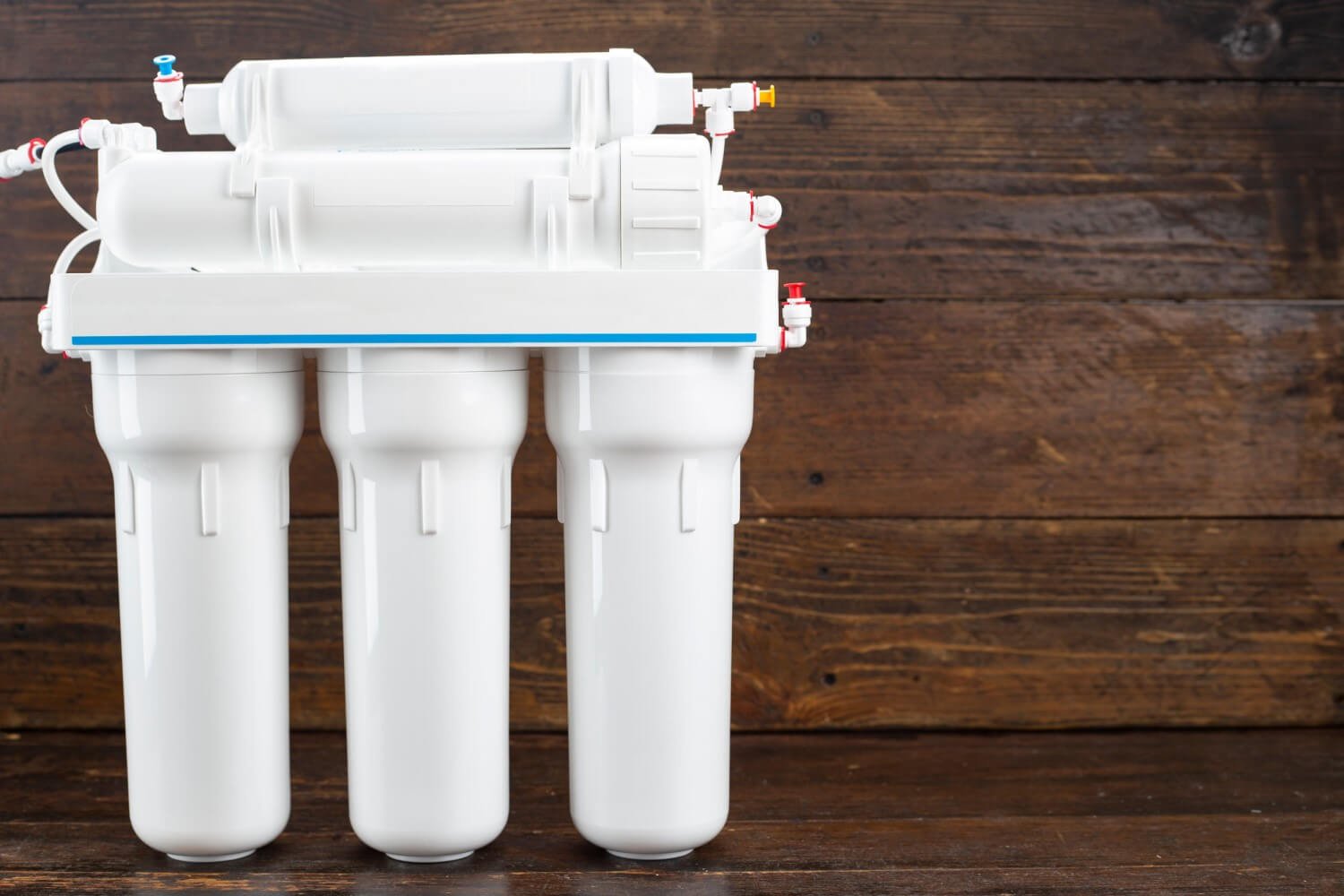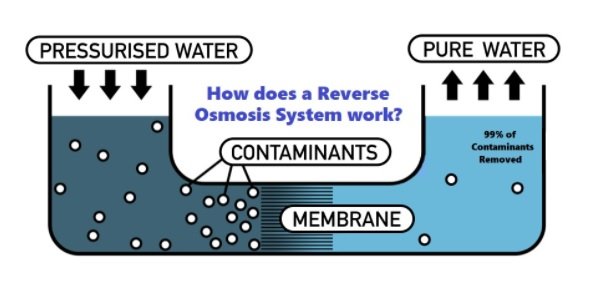What Contaminants Does Reverse Osmosis Remove?
JUMP TO: WATER DE-CONTAMINATION METHODS / PRE AND POST-TREATMENT / MEASURES OF CONTAMINATION / NSF CERTIFICATION / OTHER SOURCES OF POTENTIAL CONTAMINATION / SUMMARY
Author: Sam Brilleman
The Short Version
A reverse osmosis system will remove up to 99% of over 1,000 contaminants from your water, including:
SEDIMENT: dirt, soil, rust, debris, etc.
AQUEOUS SALTS: sodium, chlorine, chloramine, nitrate, etc.
METAL IONS: lead, copper, arsenic, zinc, nickel, chromium, etc.
VOLATILE ORGANIC COMPOUNDS (VOCs): formaldehyde, benzene, trihalomethanes (THMs), Methylene Chloride, etc.
PFAS: perfluorooctanoic acid (PFOA) and perfluorooctane sulfonic acid (PFOS)
The Long Version
The biggest benefit of investing in a reverse osmosis (RO) system is improved water quality. You may be drawn to simple pitcher filters or charcoal sticks which you can simply drop into a jug. Whilst those will definitely improve the taste of your water, RO systems almost always prove a better long-term solution.
RO systems can accommodate a larger number of people, are more convenient and surprisingly inexpensive when compared to bottled water. Nevertheless, it’s important to know what an RO system can do, in terms of water safety and the contaminants removed.
If you love reading this article, then you'll likely love reading some of our other water purification content:
WATER DE-CONTAMINATION METHODS
There are many ways of sanitizing water, though results can vary drastically between processes. The precise contaminants that can be eliminated depends heavily on the way in which the water is treated.
Distillation
As basic a water treatment as it is, distillation eliminates a wide range of contaminants through simply boiling water and collecting condensing vapors. Distillation systems will remove bacteria and viruses, along with well-known dangers, like lead, arsenic, fluoride and asbestos.
The downside is that installing such a system at home requires a lot of space and money. As it’s dependent on electricity, running costs as are considerably high and you’ll have no way to clean water in the event of a power outage. Distillation systems also eliminate necessary minerals. Because your body cannot produce them independently, long-term reliance on distillation may lead to mineral deficiencies.
Filtration
As a science teacher may explain, filtration is the physical process of separating solid and fluid with use of an absorbent medium (filter), through which fluid passes while solid matter is retained. In essence, contaminants are literally too big to get through the pores of a surface.
Pitcher and charcoal stick filters will remove sediment (dirt, rust, gravel) and micro-plastic from water, as well as improving taste and odour by eliminating chlorine. Filters can also reduce heavy metals, such as lead, arsenic and copper particles.
The effectiveness of a filtration system depends on the pore size, which is categorized as micro-filtration (0.1 micron), ultra-filtration (0.01) and nano-filtration (0.001). While increasingly finer pore sizes have greater success at removing bacteria and viruses, filtration is still inefficient at treating many chemical contaminants.
Reverse Osmosis
Osmosis is a natural process in which water moves through a semi-permeable layer. The water moves from a low to high pressure, such as when plants absorb water through their roots. Reverse osmosis flips this natural process, meaning that water is forced through the membrane after being pressurized.
Reverse osmosis removes a vast amount of contaminants. This includes aqueous salts, such as chlorine, chloramine, nitrate and sodium, as well as metal ions, like lead, zine, nickel, copper and arsenic.
Reverse Osmosis systems also remove certain Volatile Organic Compounds (VOCs), which includes formaldehyde and benzene, which cannot be said about distillation. At the same time, RO systems still block physical particles (dirt, soil, and rust), bacteria and pathogens.
Practically all RO systems reserve a space on their product pages to celebrate their 99.9% reduction of over 1,000 contaminants. It’s not an exaggeration, rather the science is just so effective. Other kinds of water filtration cannot rival this performance, yet most under-sink RO systems are installed in only a few hours.
However, RO systems aren’t well suited to treat bacteria and viruses, which may continue to grow when introduced to your system. Manufacturers will advise that you use municipal water or treat highly contaminated water prior.
While it’s said that RO systems produce a lot of waste water, modern examples are getting impressively efficient. You won’t be adding much to the water bill, and many products don’t even need electricity.
PRE AND POST-TREATMENT OF WATER
The most integral part of a reverse osmosis system is the membrane, without which countless impurities would simply skip through into your drinking water. In order to protect this key component, supplementary filters are used to prepare the water.
Consequently, you’ll often see RO systems stating how many filtration stages they have. This simply means the number of filters, or possibly layers if a single filter contains multiple stages.
Aside from filters, there are numerous things that can be done after the reverse osmosis process to enhance the final product. The most common pre and post-stages found are:
POLYPROPYLENE (PP) FILTER: Mechanically removes sand, dirt and rust particles, amongst others. It’s a pre-filter, appearing before the RO membrane, in order to protect the system from larger debris.
CARBON BLOCK (CB) FILTER: A filter made from a solid block of compressed carbon. They are incredibly effective at filtering a multitude of smaller contaminants. They are used as a pre-filter to remove contaminants and as a post-filter to ‘polish,’ by removing lingering taste and odour.
GRANULAR ACTIVATED CARBON (GAC) FILTER: A filter made from ground carbon that is held together in a cartridge. They are used for the same purposes as a CB filter, though GAC filters aren’t as effective. However, GAC filters do allow for a faster flow rate, making them preferable in certain applications.
COMPOSITE FILTER (CF): Typically a combination of PP cotton layers with an activated carbon section. These filters achieve the same results as their constituents yet are presented as a single filter.
MINERAL FILTER: Introduces essential minerals back into the water. A re-mineralizing post-filter is usually the last stage of the system, leaving you with perfect drinking water.
ULTRAVIOLET DISINFECTION: More comprehensive RO systems may include UV-light treatment, which can eliminate up to 99% of dissolved solids, heavy metals, bacteria, viruses and microorganisms.
MEASURES OF CONTAMINATION
Total dissolved solids (TDS) is the term used to describe the amounts of both organic and inorganic matter present in solution in water. Essentially, it’s a numerical measurement of water contamination, which covers minerals, metals, salts and ions.
Generally, a TDS up to 300 mg/L is considered excellent; up to 600 mg/L is fair; up to 900mg/l is considered poor, and anything over 1,000 mg/L is considered unsafe. The US Environmental Protection Agency (EPA) recommends that water with a TDS level over 500 mg/L should be treated. At this concentration, they say you should recognize hardness, miscolouring, deposits and changes to taste.
Most RO systems reduce TDS in water to optimal values of between 150 and 250 mg/L. It’s important to note that you shouldn’t eliminate all of the total dissolved solids. Even though some RO systems can bring the number down to 50mg/l, you wouldn’t want to do so. At this level, you may notice a flat taste and you won’t be able to absorb the essential nutrients your body requires.
If source water has abnormally high TDS, pre-treatment of the water may be needed before it enters the RO system. Pre-filters can help to prolong the lifespan an RO membrane, yet exposure to higher levels of contaminants will mean more frequent replacement of components.
RO systems typically come with a TDS meter, which will allow you to see current TDS and adjust to your desired amount. Independent testing has shown these readings to be highly accurate.
NSF CERTIFICATION
The National Sanitation Foundation (NSF) is a non-profit organization working to standardize food safety and sanitation. They provide various certifications, though a few relate specifically to a water filter’s ability to reduce contamination.
NSF42 (AESTHETIC EFFECTS): Reduction of chlorine, chloramine, iron, manganese, zinc (among others) and the reduction of bad taste and odour
NSF53 (HEALTH EFFECTS): The reduction of over 50 contaminants, the most popular including lead, Cryptosporidium, VOCs and chromium
NSF401 (INCIDENTAL CONTAMINANTS): reduction of specific compounds, including prescription drugs, over-the-counter medications, herbicides, pesticides and chemical compounds.
** Aesthetic effects are defined as taste, odour, colour, salinity and hardness. They are most commonly influenced by salts and metals.
** Health effects are defined as purity, cleanliness and safety. These are influenced by microbes, chemicals and various inorganic compounds.
Manufacturers may or may not let you know if their products meet the National Sanitation Foundation (NSF) food safety and sanitation standards. Always look out for NSF certification, as it’s a clear indication that a product is a little more genuine and committed to quality.
OTHER SOURCES OF POTENTIAL CONTAMINATION
PLASTIC LEECHING: The raw materials that manufacturers use to produce their RO systems is a factor in the subsequent sanitation of the water. For example, BPA-free plastics won’t leech pollutants back into the water, whereas less health-conscious products might.
While an RO system can remove lots of impurities, they won’t be able to deal with BPA, so it’s important to source out the higher build quality of trusted manufacturers.
STORAGE TANK: Some RO systems do not make use of a tank, though those that do should be cleaned periodically. Sediment can easily accumulate and, if left unchecked, contaminate the water.
SUMMARY
To ensure that your water stays contaminant-free, regularly inspect your filters. Manufacturers recommend that you replace pre-filters every 6 to 12 months, whilst the RO membrane can be replaced every 2 to 5 years.
In some cases, a membrane may last as long as 8 years, though it will depend on your water quality and level of maintenance.
A well-looked-after RO system will happily continue to eliminate up to 99% of over 1,000 contaminants, making it an unmatched, cost-effective method of filtering your drinking water.
MORE INFORMATION
If you found this review article useful, then you'll likely love getting a taste of our other water purification content:
Or check out our entire list of Product Reviews or Knowledge Base Articles for more healthy living content.





